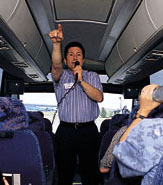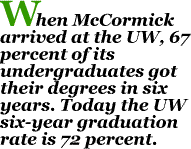Being Creative on Football Field, in Classroom
If White's and Hood's departures caused some notice, nothing matched the uproar over the quick exit of former Football Coach Jim Lambright in December 1998—or the hiring a few weeks later of Rick Neuheisel. Some alumni were upset that a loyal coach who had been on the staff for 30 years was suddenly let go; others were appalled by the new coach's million-dollar compensation package.
McCormick says he was involved in both decisions. "I was behind the scenes, (Athletic Director) Barbara (Hedges) was in front, where she belonged, and she handled it very, very well. We worked on this consultatively, which I believe you have to when a personnel issue is so visible as the football coach. Really, it is the most visible appointment at the whole University with the possible exception of the president—and I'm not even sure about that," he says.

President McCormick answers questions from faculty during a bus tour of Washington. Photo by Mary Levin.
McCormick says reaction to Neuheisel's salary was not nearly as contentious as the media reported. "I don't think I received more than five letters about that. What I said in response was that to perform with the best you've got to pay market-based salaries, and that's true whether you're hiring a chemist or a football coach."
He points out that the UW's $27 million athletic program is built around revenues generated by football. There are no state-appropriated or tuition revenues involved. "You need someone who is capable of managing that business," he explains, as well as training student-athletes. Neuheisel, he says, was an excellent choice for both roles.
Unlike the majority of athletic programs around the nation, the UW's is self-supporting. "There are a great many other universities, including one of my former universities, where the intercollegiate athletic program has become a huge draw upon resources that otherwise could go to the academic program. We don't have that situation at the University of Washington," he notes.
While pleased with the success of the athletic program, McCormick quickly shifts to the bigger picture when summarizing his first five years. He cites the "massive integration" of the UW's teaching, research and public service missions and a shift from the UW's relative isolation to "a much greater outward orientation" toward surrounding communities.
A distinctive strength of an outstanding research university is the opportunity its undergraduates have to learn from some of the best minds in America. Last year, the UW found that 24 percent of its graduating seniors had participated in at least one research project during their time on campus. More and more students are also serving as interns, community-service volunteers or mentors, in what the University calls "experiential learning."

"We've also changed the way we relate externally," the President notes, building stronger ties with K-12 education, community colleges, other four-year institutions and with private business across the state. In the K-12 arena, McCormick lured former New York Public Schools Chancellor Rudy Crew away from the Big Apple to head the UW's new K-12 Leadership Institute. The UW also has a partnership with Seattle Public Schools to launch the John Stanford International School, a new elementary school with an international emphasis and a "Generation-2" Internet hook-up.
Relations with another external group—the UW's 300,000 living alumni—remain strong, he adds. "The University is really lucky to have tens of thousands of alumni in our state and beyond. The University has always depended on its alumni and that dependence will deepen in years ahead," he says.
McCormick says alumni would be surprised by how much the University has changed in the way it does its business. "We can't fulfill all of the expectations or seize new opportunities without reinventing pretty significantly how we operate internally," he says.
Soon after he arrived, McCormick realized the University was going to have to be more creative if it was going to launch new initiatives. With the support of the faculty, deans and the regents, he started a new budget procedure that captures a small percentage of each department's operating budget. The money goes into a pool to fund new initiatives in teaching, research and public service. Long-term grants come from the University Initiatives Fund and one-year awards are offered by the Tools for Transformation program.
Faculty panels evaluate the proposals and funding is awarded in a competitive process. "There are some concrete expectations that go with the money and strong accountability measures at the end of the line," he adds.
- Return to June 2000 Table of Contents
